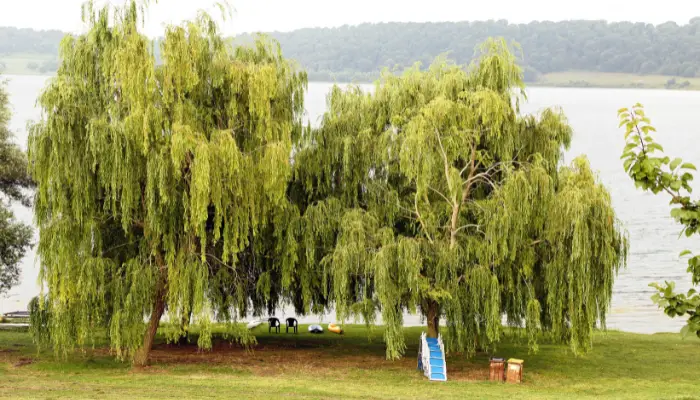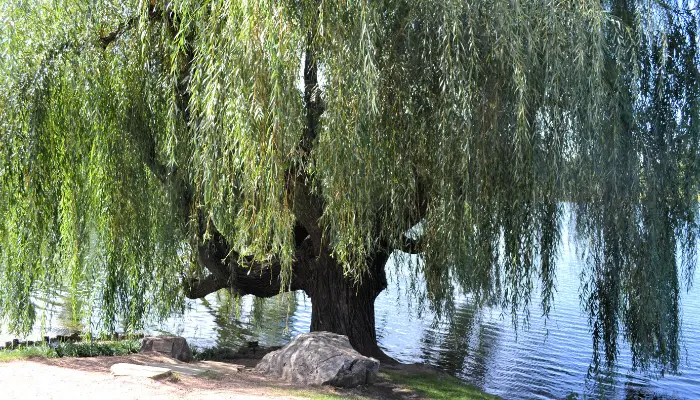The Weeping Willow is definitely the first tree that comes to mind when you think of famous trees that adorn the landscape with their graceful and melancholic beauty.
Its unique appearance which is defined by delicate, slender leaves and graceful, pendulous branches has made it a well-liked representation of tranquility and natural elegance.
If you are wondering what a weeping willow tree looks like then, continue reading.
What Does a Weeping Willow Tree Look Like?

When first encountered, the Weeping Willow exhibits itself as a work of botanical art.
Its distinctive characteristic is the long, thin branches that gently cascade towards the Earth, forming an enchanting curtain of lush greenery that sways in the softest breezes with an alluring elegance.
The name “Weeping Willow” comes from the depressing feeling these branches give off, as though they are crying or bowing in thoughtful respect to the outside world.
Equally noteworthy, the Weeping Willow’s leaves exhibit individuality.
Light to medium green shades make up the palette of these leaves, which are characterized by their lance-shaped, fine, linear form.
These leaves, which have delicate serrations along their edges, are usually placed alternately on the branches to form a pattern that is both rhythmic and harmonious.
During the spring and summer, they combine to form a lush canopy that provides shade and peace to those who are lucky enough to stay under it.
Willow Tree Size and Shape
With their massive stature, Weeping Willows are a formidable competitor in the world of botanical giants.
These magnificent trees typically reach heights of 30 to 50 feet, though some very special examples have been known to reach even higher elevations.
Their canopy, which reaches up to 35 feet or more, creates a wide, encompassing shade that gives everyone beneath it a feeling of safety and comfort.
It’s common to describe the shape of a Weeping Willow tree as having a broad, rounded crown.
It appears to be a slightly weeping or umbrella-like shape due to the branches’ gentle drooping in their distinctive way.
The delicate leaves and the elegantly pendulous branches work together to create a visually stunning and incredibly inviting scene.
Willow Tree Bark and Trunk
The bark of the Weeping Willow is remarkably unique and visually captivating, especially in its mature phase.
Its colors range from grayish-brown to brown, and its deep fissures and uneven ridges add to its unique appearance.
The bark of the tree may change over time, becoming more furrowed and scaly in texture, which adds to the tree’s overall visual appeal.
The tree’s trunk stands in striking contrast to the majesty of its canopy.
Generally quite thin, it frequently bears the faint kinks and bendings that bear witness to the tree’s age and experience.
The image is one of timeless beauty and character, greatly enhanced by the contrast between the flowing branches and the graceful trunk.
Seasonal Changes of Willow Tree
Weeping willows are magical trees, and their seasonal transformations only serve to enhance their charm.
As springtime arrives, these trees erupt with vibrant, lush green leaves that announce the arrival of days that are warmer and more colorful.
During the height of summer, their canopy is a sight to behold, a haven of lush greenery that offers not only shade but also a place to retreat and reflect.
When autumn arrives, the leaves change into a stunning golden-yellow color and then begin to gently fall, forming an enthralling leaf carpet beneath the tree.
The Weeping Willow never loses its charm, even in the bleakness of winter when the branches are stripped bare.
Its delicate, graceful architecture and intricate branching structure become visible at this time, adding to its year-round appeal.
Cultural and Ecological Significance
In addition to being aesthetically pleasing, weeping willows have significant cultural and ecological roles.
In literature, art, and folklore, it represents melancholy, reflection, and sublime beauty.
It is frequently found in gardens and parks, offering comfort to people looking for a break from the hectic pace of modern life.
Its drooping branches and peaceful aura evoke feelings of calm and contemplation.
Ecologically speaking, weeping willows are renowned for their extraordinary capacity to adapt to damp or marshy settings.
They are essential for stabilizing the soil along riverbanks, reducing erosion, and maintaining the integrity of natural landscapes.
They are especially useful in areas that are prone to flooding because of their large root systems’ capacity to absorb excess water.
The Weeping Willow tree is a testament to the artistry and grace of the natural world.
Its slender, weeping leaves, cascading branches, and unique form make it a true masterpiece of nature.
Whether admired in the serene confines of a meticulously tended garden or revered along the peaceful banks of a meandering river, the Weeping Willow’s captivating allure and ecological significance ensure it remains a perennial fixture in the tapestry of our natural surroundings.


